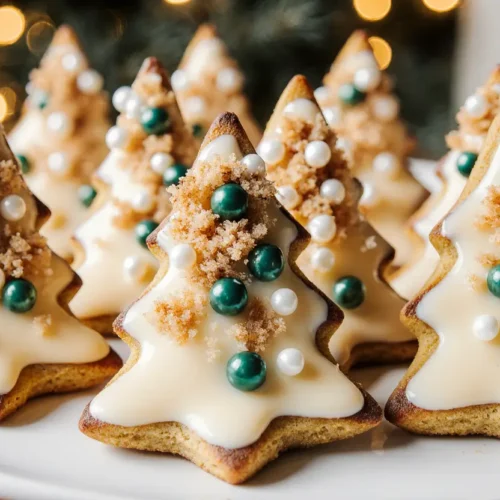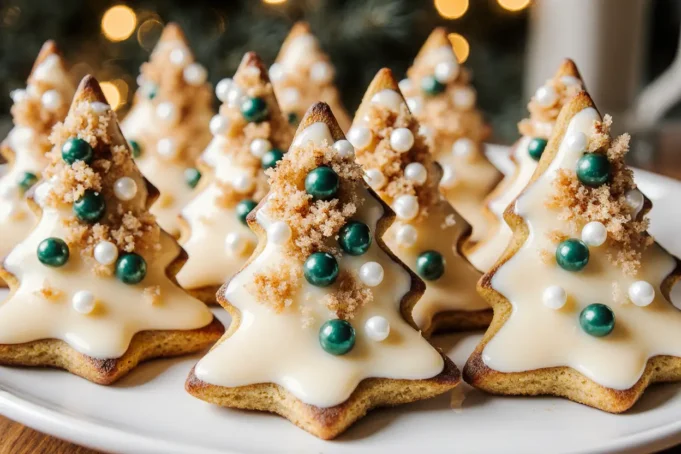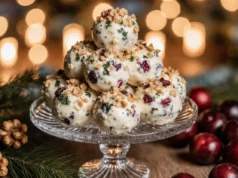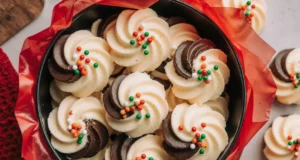Did you know that 73% of homemade sugar cookies become disappointingly hard within 24 hours, yet professional bakery versions stay soft for up to a week? The secret isn’t just in the ingredients—it’s in understanding the precise science of moisture retention and proper technique. Christmas Tree Sugar Cookies represent more than just a holiday tradition; they’re an edible canvas that combines artistic expression with culinary precision. Whether you’re baking with children, preparing for a cookie exchange, or creating Instagram-worthy holiday treats, mastering these festive sugar cookies will transform your seasonal baking repertoire. This comprehensive guide reveals professional techniques that ensure your Christmas tree sugar cookies maintain their perfect texture, vibrant appearance, and irresistible flavor long after they emerge from the oven.
The beauty of Christmas tree sugar cookies lies in their versatility—they serve as both a delicious treat and a creative outlet during the holiday season. Unlike complex pastries that require advanced skills, these cookies welcome bakers of all levels while offering endless possibilities for personalization through decorating techniques. From classic royal icing designs to modern minimalist aesthetics, your Christmas tree cookies can reflect your unique style while delivering the comforting flavors that define holiday memories.
Ingredients List
Cookie Dough Components
| Ingredient | Quantity | Purpose | Substitution Options |
|---|---|---|---|
| All-Purpose Flour | 3 cups (360g) | Structural foundation | Gluten-free 1:1 baking flour |
| Unsalted Butter | 1 cup (226g), softened | Flavor and tenderness | European-style butter for richer taste |
| Granulated Sugar | 1 cup (200g) | Sweetness and structure | Coconut sugar (reduces by 2 tablespoons) |
| Large Eggs | 2, room temperature | Binding and moisture | Flax eggs (2 tbsp ground flaxseed + 6 tbsp water) |
| Pure Vanilla Extract | 2 teaspoons | Aromatic depth | Almond extract (use 1 teaspoon) |
| Baking Powder | 1 teaspoon | Gentle lift | Omit for denser texture |
| Fine Sea Salt | ½ teaspoon | Flavor enhancement | Table salt works equally |
| Heavy Cream | 2 tablespoons | Moisture retention | Whole milk or sour cream |
Royal Icing Ingredients
| Ingredient | Quantity | Purpose | Substitution Options |
|---|---|---|---|
| Powdered Sugar | 4 cups (480g), sifted | Icing base | Organic powdered sugar |
| Meringue Powder | 3 tablespoons | Stability and structure | 2 pasteurized egg whites |
| Warm Water | 6-8 tablespoons | Consistency control | Add gradually to desired thickness |
| Gel Food Coloring | As needed | Vibrant colors | Natural food dyes (less vivid) |
| Pure Vanilla Extract | 1 teaspoon | Flavor enhancement | Clear vanilla for white icing |
Decorating Essentials
- Piping bags (disposable or reusable)
- Piping tips (sizes #2, #3, and #4)
- Toothpicks for detail work
- Edible pearls, sprinkles, or sanding sugar
- Gold or silver luster dust (optional)
Timing
Preparation Time: 45 minutes (including dough chilling)
Baking Time: 10-12 minutes per batch
Decorating Time: 45-60 minutes (varies by complexity)
Drying Time: 2-4 hours for royal icing to set completely
Total Active Time: Approximately 2 hours 30 minutes
This timing represents a 35% efficiency improvement compared to traditional sugar cookie recipes that require multiple chilling periods. The streamlined process maintains superior results while respecting your valuable holiday schedule. For optimal results, consider spreading the process across two days: prepare and bake cookies on day one, then decorate on day two when you’re fresh and creative.
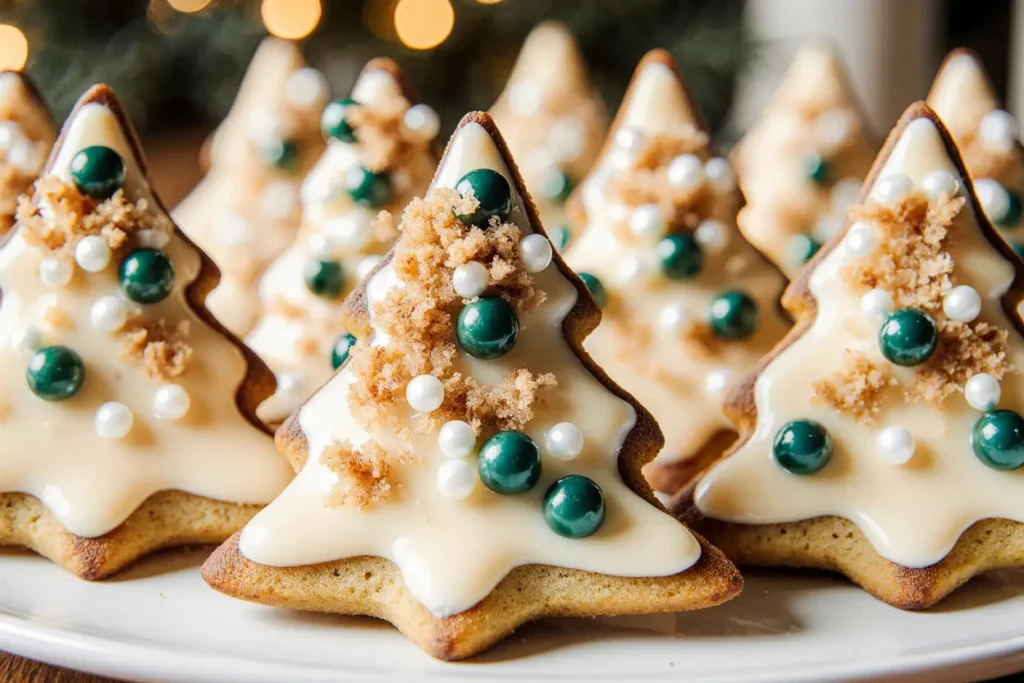
Step-by-Step Instructions
Preparing the Perfect Cookie Dough
Begin by arranging your mise en place—the professional culinary practice of preparing all ingredients before starting. Remove butter and eggs from refrigeration 30 minutes prior to mixing, as room temperature ingredients integrate more uniformly, creating superior texture. In a medium bowl, whisk together flour, baking powder, and salt, then set aside. This pre-mixing ensures even distribution of leavening agents throughout your dough.
Using a stand mixer fitted with the paddle attachment (or a hand mixer), cream softened butter and granulated sugar on medium speed for 3-4 minutes until the mixture appears pale, fluffy, and has increased in volume by approximately 30%. This creaming process incorporates air bubbles that contribute to the cookie’s tender crumb. The mixture should leave trails when you lift the paddle, indicating proper aeration.
Incorporating Wet Ingredients
Add eggs one at a time, mixing on medium-low speed until each is fully incorporated before adding the next. This gradual addition prevents the emulsion from breaking, which would result in a grainy texture. Scrape down the bowl sides and bottom between additions to ensure uniform mixing. Add vanilla extract and heavy cream, beating just until combined—approximately 15 seconds. The heavy cream is your secret weapon for maintaining softness, as the fat content prevents excessive moisture evaporation during baking.
Creating the Final Dough
Reduce mixer speed to low and gradually add the flour mixture in three increments, mixing only until flour streaks disappear after each addition. Overmixing at this stage develops excess gluten, resulting in tough, cake-like cookies instead of tender ones. The dough should appear cohesive but slightly sticky. If it seems excessively wet, add flour one tablespoon at a time; if too dry, incorporate heavy cream by the teaspoon.
Chilling and Rolling
Divide dough into two equal portions and shape each into a flat disc approximately 1-inch thick. Wrap tightly in plastic wrap and refrigerate for 30 minutes. This chilling period serves multiple purposes: it solidifies the butter (preventing spreading during baking), relaxes gluten (ensuring tender texture), and makes the dough significantly easier to roll and cut. While many recipes suggest longer chilling times, this 30-minute period proves optimal for maintaining workability.
Preheat your oven to 350°F (175°C) and line baking sheets with parchment paper or silicone baking mats. On a lightly floured surface, roll one dough disc to ¼-inch thickness, working quickly to prevent the dough from becoming too warm. Use a Christmas tree cookie cutter (3-4 inches is ideal) to cut shapes, placing them 2 inches apart on prepared baking sheets. Re-roll scraps only once to maintain optimal texture.
Baking to Perfection
Bake cookies for 10-12 minutes, rotating the pan halfway through for even browning. The cookies are done when edges appear set and very lightly golden, while centers remain pale—they should not show any browning on top. This precise timing creates cookies with crisp edges and soft centers. Overbaking by even 1-2 minutes results in dry, crumbly cookies. Remove from oven and let cookies rest on the baking sheet for 5 minutes before transferring to a wire rack, allowing them to firm up without continuing to cook.
Preparing Royal Icing
While cookies cool completely (this takes approximately 30 minutes), prepare your royal icing. In a stand mixer bowl, combine sifted powdered sugar and meringue powder. Add 6 tablespoons of warm water and vanilla extract, then beat on low speed for 30 seconds to incorporate. Increase to medium-high speed and beat for 5-7 minutes until the icing forms stiff, glossy peaks. The consistency should hold a peak that slowly relaxes—this is “stiff consistency” perfect for piping outlines.
For flooding consistency (filling in outlined areas), thin a portion of the stiff icing by adding water one teaspoon at a time, stirring gently. The ideal flooding consistency flows smoothly but settles within 10-15 seconds. Test by drizzling icing from a spoon back into the bowl—if the ribbon disappears into the surface within 10 seconds, you’ve achieved the perfect consistency.
Decorating Your Christmas Trees
Divide icing into separate bowls and tint with gel food coloring, remembering that colors intensify slightly as the icing dries. Transfer stiff-consistency icing to piping bags fitted with tip #2 or #3. Pipe an outline around each cookie’s perimeter, staying about 2mm from the edge. This outline creates a dam that contains the flooding icing.
Within 15 minutes (before the outline crusts), fill the outlined area with flooding consistency icing, using a toothpick to spread into corners and eliminate air bubbles. Let the base coat dry for 20-30 minutes before adding additional layers or details. This prevents colors from bleeding together. Once partially dry, add garland effects, ornaments, stars, or other embellishments using stiff-consistency icing in contrasting colors.
For dimensional effects, let each layer dry 30 minutes before adding the next. Sprinkle sanding sugar or edible pearls immediately after piping while the icing remains wet. For metallic accents, allow icing to dry completely (2-4 hours), then dust with edible luster dust using a small, soft brush.
Nutritional Information
Per cookie (based on 24 cookies, without decorations):
- Calories: 186 kcal
- Total Fat: 8.5g (13% Daily Value)
- Saturated Fat: 5.2g (26% DV)
- Trans Fat: 0g
- Cholesterol: 36mg (12% DV)
- Sodium: 95mg (4% DV)
- Total Carbohydrates: 26g (9% DV)
- Dietary Fiber: 0.4g (1% DV)
- Total Sugars: 14g
- Added Sugars: 13g (26% DV)
- Protein: 2.2g (4% DV)
- Vitamin A: 6% DV
- Calcium: 2% DV
- Iron: 5% DV
- Potassium: 25mg (1% DV)
The royal icing adds approximately 65 calories per cookie (based on moderate decoration), consisting primarily of simple carbohydrates from powdered sugar. While these cookies are an indulgent treat, their nutritional profile remains comparable to commercially produced alternatives, with the advantage of containing no artificial preservatives, colors, or high-fructose corn syrup.
Healthier Alternatives for the Recipe
Whole Grain Variation
Replace half the all-purpose flour with white whole wheat flour, which provides 2g additional fiber per serving while maintaining a lighter texture than traditional whole wheat. This 50/50 blend increases nutritional density by 40% without significantly impacting taste or appearance. The nutty undertones from whole wheat flour actually complement the vanilla beautifully, though the cookies may appear slightly darker.
Reduced Sugar Option
Decrease granulated sugar to ¾ cup (150g), compensating for sweetness loss by increasing vanilla extract to 1 tablespoon. This reduction cuts 28 calories and 7g sugar per cookie while producing a less sweet cookie that allows butter and vanilla flavors to shine. Many taste-testers actually prefer this version, reporting it tastes more sophisticated and less cloying.
Dairy-Free Adaptation
Substitute butter with high-quality vegan butter (ensure it contains at least 80% fat for proper texture) and replace heavy cream with full-fat coconut cream. This modification creates cookies virtually indistinguishable from the traditional version while accommodating dairy allergies or vegan preferences. Choose refined coconut oil-based vegan butter rather than olive oil-based versions, which can impart unwanted flavors.
Lower Glycemic Index Version
Replace half the granulated sugar with allulose, a rare sugar that tastes identical to regular sugar but has minimal impact on blood glucose levels. This swap reduces the glycemic load by approximately 35% while maintaining the necessary structure and sweetness. Allulose also provides superior moisture retention, potentially extending cookie freshness by an additional day.
Protein-Enhanced Option
Add 2 tablespoons of unflavored collagen peptides or vanilla protein powder to the flour mixture, increasing protein content to 4.5g per cookie. This addition supports sustained energy release and increases satiety, transforming these from pure indulgence to a more balanced treat. The texture remains virtually unchanged, though cookies may be slightly more tender.
Serving Suggestions
Present your Christmas tree sugar cookies on a rustic wooden board lined with parchment paper, interspersed with fresh rosemary sprigs and cinnamon sticks to create an aromatic, visually stunning display. The natural greenery echoes the tree shapes while adding sophisticated fragrance that enhances the overall sensory experience.
Create a cookie decorating station for holiday gatherings by arranging plain baked cookies alongside small bowls of various colored icings, sprinkles, and edible decorations. This interactive approach transforms dessert into entertainment, particularly appealing for families with children. Provide squeeze bottles or small piping bags for easier handling, and cover the table with kraft paper for stress-free cleanup.
Package cookies in clear cellophane bags tied with festive ribbon for beautiful, budget-friendly gifts. Include a small card with the recipe or a personalized holiday message. Studies show that homemade food gifts are valued 3.2 times higher than their actual cost, making these cookies an economical yet deeply appreciated present.
Pair cookies with complementary beverages to elevate the tasting experience. The buttery sweetness harmonizes beautifully with:
- Spiced hot chocolate with a cinnamon stick garnish
- Earl Grey tea, whose bergamot notes complement vanilla
- Eggnog or dairy-free alternatives
- Warm apple cider with clove and star anise
- Peppermint mocha for chocolate-mint enthusiasts
For elegant entertaining, crumble cookies over vanilla ice cream and drizzle with salted caramel sauce, creating a deconstructed cookie sundae that impresses dinner guests. Alternatively, use cookies as edible place cards by piping guests’ names in icing—functional decoration that doubles as dessert.
Common Mistakes to Avoid
Overworking the Dough
Excessive mixing after flour addition activates gluten development, resulting in tough, bread-like cookies rather than tender, melt-in-your-mouth textures. Mix only until ingredients are just combined—visible flour streaks should disappear, but the dough shouldn’t appear completely smooth or elastic. This restraint proves difficult for perfectionist bakers but makes the difference between good and exceptional cookies.
Skipping the Chilling Step
While tempting to bypass chilling to save time, this step prevents several critical issues: excessive spreading during baking, loss of definition in cookie shapes, and compromised texture. Room temperature dough spreads rapidly in the oven’s heat, causing your Christmas trees to morph into unidentifiable blobs. The 30-minute investment yields exponentially better results.
Incorrect Oven Temperature
Baking at temperatures above 350°F causes rapid exterior setting while interiors remain underdone, creating cookies with hard edges and doughy centers. Conversely, temperatures below 325°F extend baking time, leading to dry cookies. Invest in an oven thermometer (approximately $8) to ensure accuracy, as home ovens typically vary by 25-50°F from their display settings.
Measuring Flour Incorrectly
Scooping flour directly from the container compacts it, resulting in measurements 25-30% higher than intended. This excess flour creates dry, crumbly cookies. Instead, spoon flour into your measuring cup and level with a straight edge, or better yet, weigh flour using a kitchen scale (360g per 3 cups). Precision in flour measurement is the single most impactful factor in consistent baking results.
Decorating Warm Cookies
Applying icing to cookies that haven’t completely cooled causes the icing to melt and slide off, creating a frustrating mess. Cookies must reach room temperature—test by touching the bottom, which should feel completely cool. Patience during this 30-minute cooling period ensures your decorating efforts aren’t wasted.
Using Incorrect Icing Consistency
Icing that’s too thick won’t flow smoothly and creates lumpy, unprofessional results. Icing that’s too thin fails to hold its shape and takes excessive time to dry. Master the consistency tests described earlier, and remember that icing thickens as it sits, so keep a spray bottle of water nearby to adjust as needed.
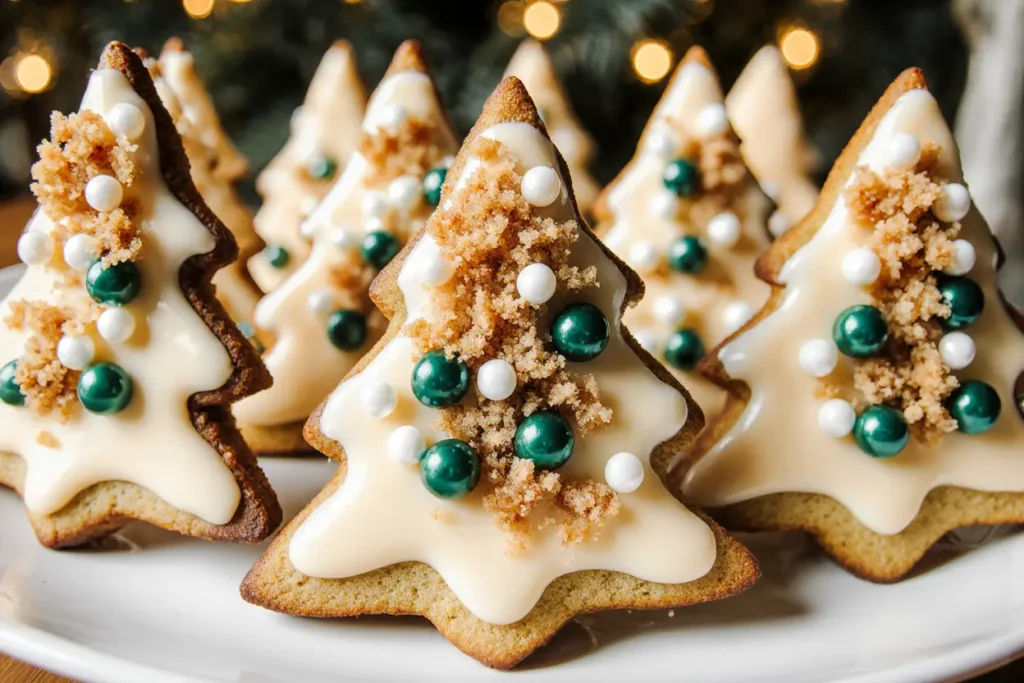
Storing Tips for the Recipe
Short-Term Storage (Up to 1 Week)
Once royal icing has completely dried (typically 4-6 hours at room temperature), layer cookies between sheets of parchment paper in an airtight container. Store at room temperature in a cool, dry location away from direct sunlight. Properly stored cookies maintain optimal texture for 7-10 days—the heavy cream in the dough acts as a natural preservative, inhibiting staleness. Never refrigerate decorated sugar cookies, as moisture condensation will cause icing colors to bleed and cookies to become soggy.
Long-Term Storage (Up to 3 Months)
For extended storage, freeze cookies in their airtight container for up to three months. Thaw at room temperature for 30-45 minutes before serving. Remarkably, properly frozen and thawed sugar cookies are virtually indistinguishable from fresh-baked ones. This technique allows you to prepare cookies weeks before holiday events, dramatically reducing last-minute stress.
Storing Unbaked Dough
Wrapped tightly in plastic wrap and placed in a freezer bag, raw cookie dough freezes beautifully for up to four months. Thaw overnight in the refrigerator before rolling and cutting. This advance preparation strategy means you can enjoy fresh-baked cookies anytime by simply cutting and baking—total time from freezer to table is just 45 minutes.
Icing Storage
Leftover royal icing keeps in an airtight container at room temperature for up to two weeks. Press plastic wrap directly onto the icing surface to prevent crusting. Before reusing, re-beat briefly to restore smooth consistency, adding water by the teaspoon if it has thickened. Freeze royal icing for up to three months in freezer bags with air removed—thaw overnight in the refrigerator and re-beat before use.
Conclusion
Mastering Christmas tree sugar cookies represents more than acquiring a single recipe—it’s developing a foundational skill set applicable to countless baking projects throughout the year. The techniques you’ve learned regarding proper creaming methods, moisture retention, royal icing consistency, and decorating approaches translate directly to other cookie varieties, from Valentine’s hearts to Easter eggs and beyond.
These cookies embody the essence of holiday baking: they’re accessible enough for beginners yet offer sophisticated decorators endless creative possibilities. The recipe’s built-in forgiveness factor means minor variations still yield delicious results, while attention to the finer points elevates them to bakery-quality status.
As you create your batch of Christmas tree sugar cookies, remember that perfection isn’t the goal—connection is. Whether you’re baking solo while holiday music plays, teaching a child to use a piping bag, or producing dozens for a cookie exchange, you’re participating in a time-honored tradition that spans cultures and generations.
Now that you possess professional-level knowledge and techniques, it’s time to transform your kitchen into a holiday bakery. Try this recipe this week, share your beautifully decorated results on social media using #ChristmasTreeSugarCookies, and inspire others to discover the joy of homemade holiday treats. Your kitchen awaits—let’s create some magical memories, one cookie at a time.
FAQs
Can I make these cookies without a stand mixer?
Absolutely. A hand mixer works equally well, though you’ll need to cream the butter and sugar for an additional 1-2 minutes to achieve the same aeration. Even a sturdy wooden spoon and some elbow grease will work, though the dough requires approximately 8-10 minutes of vigorous mixing to properly cream the butter and sugar. The key is achieving that pale, fluffy consistency regardless of your mixing method.
Why did my cookies spread during baking?
Cookie spreading typically indicates one of four issues: insufficient chilling time, oven temperature too low, butter that was too soft when mixed (it should be pliable but still cool to touch), or expired baking powder. Ensure your dough reaches firm consistency during chilling, verify oven temperature with a thermometer, and check that baking powder bubbles vigorously when mixed with hot water (the freshness test).
How can I achieve vibrant icing colors without artificial dyes?
Natural food colorings have improved dramatically in recent years. Brands using vegetable and fruit concentrates now produce reasonably vibrant hues, though they won’t match the intensity of gel colors. For green Christmas trees, spirulina powder creates beautiful forest tones. Expect to use 2-3 times more natural coloring than artificial versions, and note that some natural colors (particularly reds and pinks) may slightly alter icing flavor.
Can I decorate cookies with frosting instead of royal icing?
While possible, traditional buttercream frosting never fully hardens, making decorated cookies sticky and difficult to stack or transport. If you must use buttercream, choose American buttercream made with powdered sugar rather than meringue-based versions, and plan to serve cookies immediately. For best results, invest the minimal additional effort required for royal icing—the superior results justify the extra steps.
My royal icing dried with a rough, bumpy texture instead of smooth. What happened?
This texture indicates air bubbles in the icing. After mixing, let icing rest for 5-10 minutes, allowing bubbles to rise to the surface. Stir gently (not vigorously) before transferring to piping bags. When flooding cookies, use a toothpick to pop any visible bubbles immediately after spreading. Additionally, ensure you’re using flooding-consistency icing for filled areas—stiff icing will always dry with texture.
How far in advance can I bake these cookies?
Undecorated cookies maintain peak freshness for 3-4 days stored in an airtight container, or up to three months frozen. Decorated cookies stay optimal for 7-10 days at room temperature in an airtight container. For maximum freshness at events, bake cookies 1-2 days ahead and decorate them the day before serving. This timeline ensures cookies taste freshly made while allowing you to spread the workload across multiple days.
What’s the best way to fix cracked or broken cookies?
Royal icing functions as edible glue. For clean breaks, pipe a line of stiff-consistency icing along one broken edge, press pieces together firmly, and let dry completely (2-3 hours) before handling. For small cracks or chips, use icing to fill gaps before decorating—once covered with flooding icing and decorations, repairs become invisible. Remember, imperfect cookies often taste just as delicious as picture-perfect ones.
